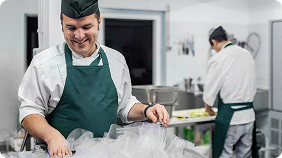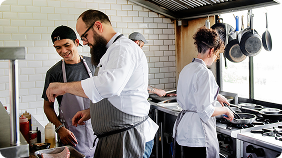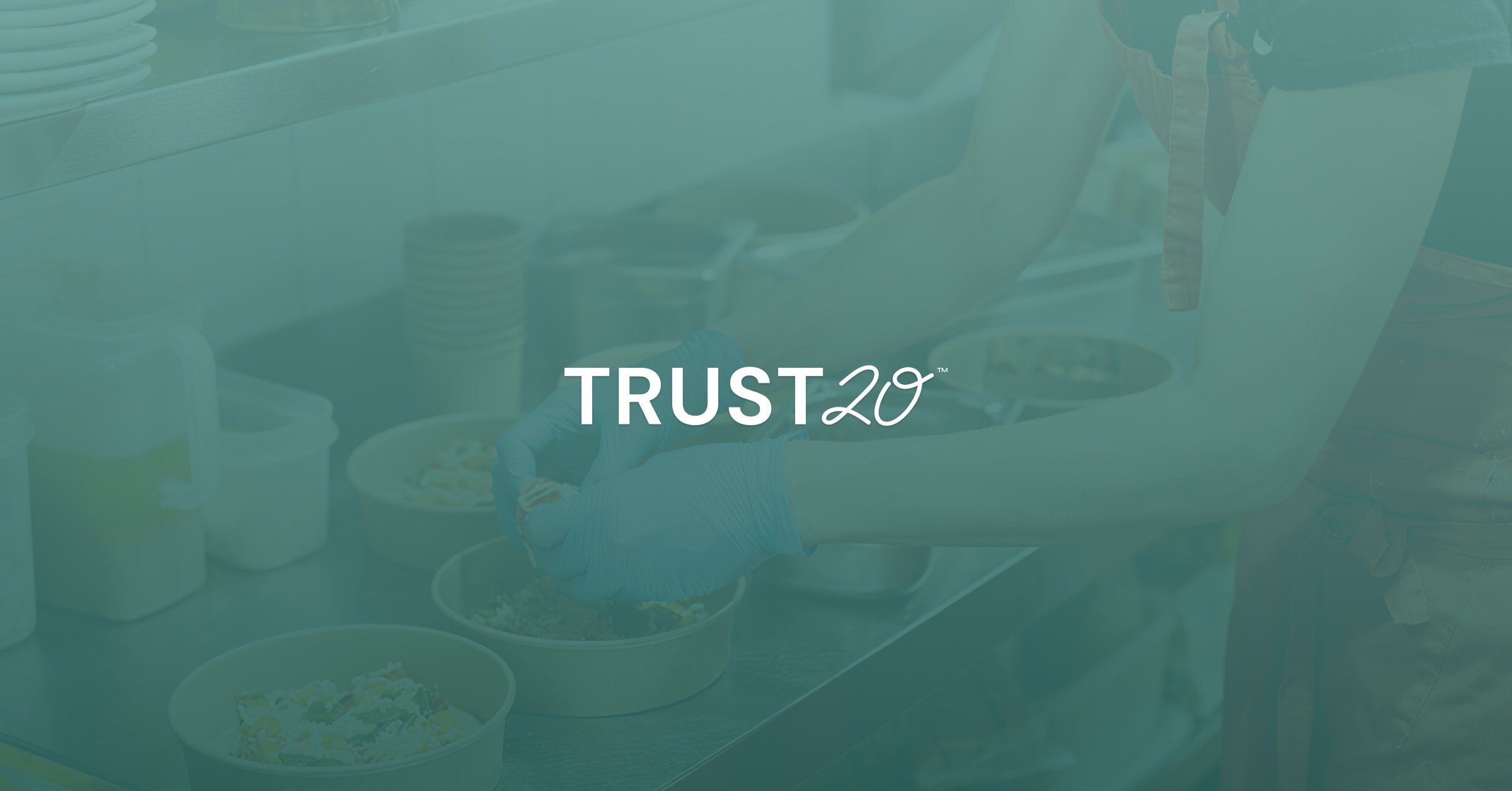Preparing to take your Certified Food Protection Manager (CFPM) exam can be nerve-wracking, especially when you know there will be a proctor’s watchful eye on your work. However, you can reduce some of the stress leading up to your testing session by preparing your space and equipment ahead of your exam appointment time.
In general, proctored exams have strict guidelines that help protect the integrity of the exam results and the credentials awarded to candidates who pass these exams. Adequately preparing your space in advance of your testing session can ensure you aren’t disqualified before you even begin.
No need to stress! This blog will discuss how to prep your space for your remote-proctored CFPM exam. We will cover:
What kinds of proctored exams are there?
How do you prepare for a remote-proctored CFPM exam?
Why are exams proctored?
Proctored exams have been a staple in academic institutions for years but are not exclusive to universities and colleges. Nowadays, many professions, including certain positions in the foodservice industry, require individuals to complete proctored exams as part of a certification process.
Proctored exams are tests conducted in a supervised environment where every candidate’s moves are monitored to help ensure there is no cheating or duplication of exam content. It also prevents candidates from having someone else sit for their testing session.
What kinds of proctored CFPM exams are there?
For your CFPM credentials to be considered valid by the Conference for Food Protection and ANSI, you must take a proctored exam from an accredited provider. There are a few styles of proctored exams out there.
Live, online, remote-proctoring
A remoted-proctored CFPM exam can be taken from almost any private space with a reliable internet connection and a computer with a webcam and microphone.
In this scenario, your CFPM exam will be delivered online, and your remote proctor will keep an eye on you through your webcam and, oftentimes, a screen share.
It is important to test your equipment before your scheduled testing session, and many exam providers will provide you with step-by-step instructions ahead of time.
In-person proctoring
Taking your CFPM exam with an in-person proctor simply means taking your exam in a physical location with a designated person overseeing you–and potentially other candidates.
In this scenario, your CFPM exam may be at a testing center or a classroom and may be delivered in paper or digital format.
Automated online proctoring
Automated proctoring is an emerging technology where candidates are recorded during their testing session, and AI analyzes the footage for signs of cheating after the exam is submitted.
This type of proctoring is still relatively new, and there haven't been many studies done to determine its effectiveness, so this style of proctoring may not result in valid credentials.
How do you prepare for a remote-proctored CFPM exam?
Arranging the perfect environment for a remote-proctored CFPM exam is essential to a smooth testing session. Let’s review some guidelines for setting up your space.
Choose a private, well-lit room
It's important to create an environment that is well-lit and free from distractions and interruptions. When you log on for your testing session, your proctor will need to be able to see your face, your desk, and the walls around you.
A quiet room in your home is usually the best place for your testing session. If quiet is hard to come by at home, consider asking a friend to use their desk or kitchen table or reserve a private room at your local library.
You’ll want to avoid public places such as coffee shops or other noisy community spaces, as proctors may tell you that the space is not secure enough for the exam to be delivered.
You must be alone while taking your remote-proctored CFPM exam. Otherwise, proctors might believe you are cheating or trying to duplicate the exam questions to distribute to other candidates.
Choose a stable surface for your computer
Make sure you have a stable surface to work on, like a table or desk. This will prevent any accidental movements that could disrupt your CFPM exam. Avoid using a bed, couch, or floor, as these softer surfaces may reduce your focus.
Clear your workspace
Ensure that your exam room is neat and tidy. You should remove any prohibited items from the space, such as electronic devices, food, or toys. Clear your desk of any books or extra papers that could be perceived as notes. If a proctor sees any of these items, they may believe you are cheating and have the right to terminate your testing session (and you won’t be eligible for a refund!).
Meazure Learning, Trust20’s remote-proctoring partner, has a great video with even more details about preparing your space for your CFPM exam.1
Remove your sunglasses, earbuds, headphones, and watch
Before your CFPM exam, you must remove any items that you’re wearing that may aid in cheating. Most testing sessions do not allow sunglasses, earbuds, headphones, and watches. If you need to wear earplugs, ensure you inform your proctor and that they remain visible at all times.
Note that hats are also not allowed during a testing session. However, religious coverings such as hijabs and turbans are allowed. If you wear a religious covering, ensure it does not obstruct your face throughout the exam.
Download Google Chrome or Firefox
As a remote-proctored CFPM exam will be delivered online, you will need to ensure you have a strong, stable internet connection on the day of your exam. Before your testing session, you should make sure you have access to Chrome or Firefox, as some exam platforms may not work on other browsers.
Have proper identification ready
You are required to present a government-issued I.D. to your proctor before beginning your CFPM exam. A current driver's license or passport are acceptable forms of I.D. and you can always check with your exam provider what other forms of photo identification can be used.
Seek testing accommodations ahead of time
It is critical that you request any testing accommodations in advance of your scheduled CFPM exam. Exam providers typically require documentation for your request, such as a doctor’s note. Don’t wait until your exam session is about to begin! Failure to notify the organization in advance may result in the denial of the accommodations you need.
Review the rules
You can reduce test anxiety by familiarizing yourself with what is allowed and is not allowed during your CFPM exam. Looking off-screen, thinking out loud, or shifting out of the camera frame can all result in the termination of your testing session, so you’ll want to be clear about what the rules are.
The online proctoring process
Once you log in to your exam platform, a remote proctor will ask to see your space. Typically, you can use your cell phone’s camera to show them the edges of your computer screen and the surrounding room. They will then instruct you to put your cell phone away. You may also be asked to use your computer’s webcam to show them the room.
Your proctor will want to see a clear view of your hands, the tabletop, and your seating area.
The workspace will need to remain clearly visible during your CFPM exam session.
Final Thoughts
Avoid last-minute panic! Set up your space, and test your webcam, microphone, and internet connection ahead of time. You can even try to simulate the exam environment by sitting in your chosen spot and running through the process of showing your space to an imaginary proctor before your exam day.
While this may feel silly, it’ll give you peace of mind that everything is set up correctly, and you’ll be able to troubleshoot any potential issues that could disturb your CFPM exam experience. Good luck–you’ve got this!
Sources:
- Meazure Learning's Youtube: Candidate Experience






.png)

.png)
